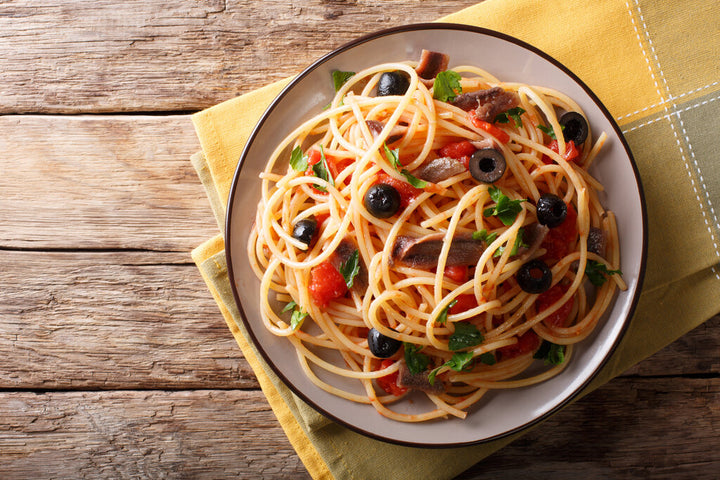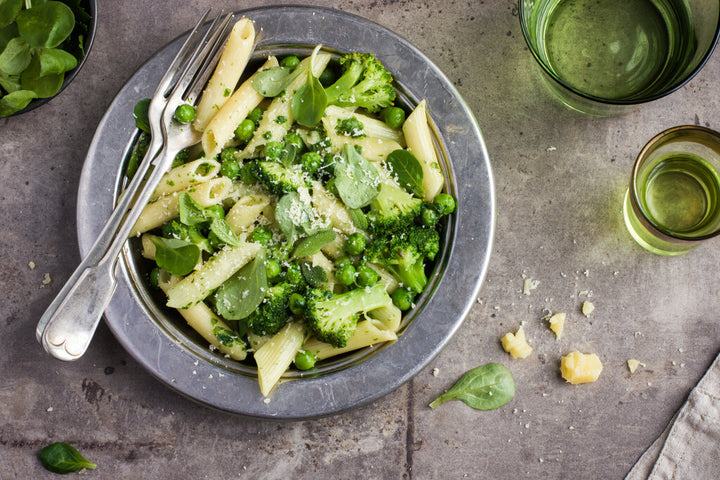You can't get much better than chowing down on super-fresh pasta smothered in your favorite sauce. With our easy homemade pasta recipe, you'll be pleasantly surprised at how simple the process can be.
With the right cooking equipment alongside a little expert advice, homemade pasta can be fun and easy to make. All it takes are four basic ingredients: flour, eggs, salt, and olive oil. You'll need a pasta maker and a food processor to make the recipe a whole lot quicker to prepare.
Homemade pasta recipe FAQ
With four simple ingredients, a food processor, and a pasta maker, you can quickly prepare homemade pasta in no time at all in your kitchen!
There's always room for improvement, though, so we decided to get our chefs together to answer the most commonly asked questions we hear about our homemade pasta recipe. Keep reading to find out more!
How do I make pasta dough without a food processor?
A food processor makes the whole process of preparing homemade pasta a whole lot smoother and easier, but it's more than possible to prepare the recipe without one, but plan to put in a little bit more time and energy!
To make the pasta dough, you can follow these steps, using the same ingredients above:
- Pour your flour directly onto the kitchen countertop (after cleaning, of course).
- Push the flour into a large mound and use your fingers to hollow out a small well in the top.
- Crack your eggs directly into the well. Add salt and olive oil, then beat the mixture together with a fork or a whisk.
- Once you beat the eggs into the well, start mixing the flour by folding it into the well.
- Slowly combine all the ingredients with the flour until you have a thicker texture.
- Next, start folding the dough into a roughly shaped ball, then spend at least 10 minutes kneading the ball until you have a soft, springy texture.
- Add extra flour if it's too sticky, or an extra egg if it's much too dry.
- When you're happy, leave the ball wrapped up tight in plastic wrap for half an hour at room temperature.
- After half an hour, you can roll and cut your dough into fresh pasta!
How do I roll pasta without a pasta maker?
Just as a food processor makes the prep process a whole lot easier, so does a pasta maker. While we highly recommend using a pasta maker if you want thin, consistent pasta, you can also get away with rolling out and cutting the dough by hand.
After preparing your dough, you can use the following steps to prepare the fresh pasta by hand, rather than with a pasta maker:
- After your dough has sat for half an hour resting at room temperature, you can take it out of the plastic wrap and place it onto a floured countertop.
- Take a sharp knife and slice the ball into four evenly sized chunks.
- Using a rolling pin, flatten one piece of dough into a roughly circular disk-shape.
- Now, using the rolling pin, keep rolling out the disk until you have the desired thickness. Keep flouring the rolling pin and the surface to stop the dough from sticking.
- When you have a long dough sheet, cut it up into equal-sized portions, then roll each piece out again to get the dough even thinner.
- When you're happy with the dough's thickness, you can start to cut it into the desired pasta shape. If you want fettuccine, slice the dough into thin strips.
- Leave the sliced pasta on a piece of parchment paper or hang it on a drying rack while you repeat the process with the rest of your dough.
Can I store fresh pasta for later?
Fresh pasta tastes best when cooked right after you roll it, but you can also store the homemade pasta for later. If you're going to use the homemade pasta within 24 hours, then store it in a resealable container in the fridge. Any longer than 24 hours, and it will start to dry out and lose its freshness.
You can also prepare your pasta in advance and dry it out overnight. You can leave the pasta to dry out on a drying rack or place it into a box and leave it on the side. Keep the pasta stored away and then boil it for around 8-10 minutes when you're ready to eat later. You can safely store pasta for months if it's adequately dried out (just like store-bought pasta).
What's the best flour for pasta?
All-purpose flour is the most common type on the market, and you'll find it in stores and supermarkets everywhere. Odds are, you already have some in your pantry. All-purpose flour is easy to turn into a dough and is the classic ingredient for traditional pasta.a
However, all-purpose flour contains wheat, so it's not always suitable for some, especially if you have particular dietary requirements or restrictions.
Wholewheat flour is a less processed version of all-purpose flour, offering more nutrients and fiber in comparison. It does have a very different taste, however. If you're looking for a low carb or gluten-free alternative, you can use almond flour instead of all-purpose flour.
Can I make vegan pasta?
Our homemade pasta recipe requires eggs, so of course, it's not a vegan option. Many dried, store-bought pasta no longer use eggs in the recipe, and you can replicate this style of pasta at home for a vegan-friendly alternative.
Eggs work as a binding agent, so instead, you can use ingredients such as xanthan gum, which will hold your flour together and stop the dough from falling apart. You can also use the same recipe we've explained above and substitute the eggs with a few cups of water. Xanthan gum should hold the dough together, especially if you can blend the ingredients in a food processor.
How long will it take to cook fresh pasta?
If you're new to preparing a homemade pasta recipe, you need to be careful how long you cook fresh pasta. You might be used to cooking dried pasta from packets, which usually takes at least 10 minutes. On the other hand, fresh pasta needs just 2 minutes before it's soft and ready to eat.
Any longer, and you'll find that your fresh pasta starts to disintegrate and fall apart. Keep stirring and checking how soft it is in the saucepan to ensure you don't overcook it.
If you enjoy your pasta al dente, you can boil it in water for around 90 seconds. The precise time it takes to cook will depend on how thick you have rolled your pasta. The thicker the pasta, the longer it will need to cook through.
Remember to strain the pasta thoroughly before serving it!
How much pasta should I prepare per person?
Our homemade pasta recipe will give roughly 1 pound worth of fresh pasta once you roll everything out. One pound of fresh pasta will be more than enough pasta for 4 servings.
The average serving size for pasta is around 3-4 ounces per person, but of course, this varies depending on how hungry you might be. You can scale up the ingredients' quantity if you need to make more servings for more people.
Is homemade pasta healthier than store-bought pasta?
Preparing a homemade pasta recipe is perfect for anyone keen to control what goes into preparing their food. You can select the best flour, the best eggs, and the best oil. You can also control the quantity of each ingredient to have a better idea of what you're eating and how much you're eating.
Compared to dried, store-bought pasta, fresh homemade pasta can have many more nutrients. Store-bought pasta doesn't often use eggs in the production process, and these are a valuable source of nutrients and vitamins. Eggs can add more cholesterol and more fat the recipe, but generally speaking, fresh, homemade pasta will have far fewer carbohydrates than dried pasta.
If you're looking for a very healthy homemade pasta style, consider changing all-purpose flour to whole grain flour. If you would like to lose a little weight, you can try a keto-friendly, low carb pasta made from almond flour and bond with xanthan gum.
Homemade pasta isn't so difficult to make after all!
You can now make delicious, fresh, homemade pasta with just four basic ingredients! Once you've practiced all of the different steps, you'll be able to homemade pasta easily and quickly, especially with a food processor and pasta maker!
Grab your flour and eggs, prepare your tomato sauce, and start cooking up homemade pasta dough. Save our guide for the next time you're craving a super fresh pasta recipe.
Leave a comment
Comments will be approved before showing up.
Also in Recipes










